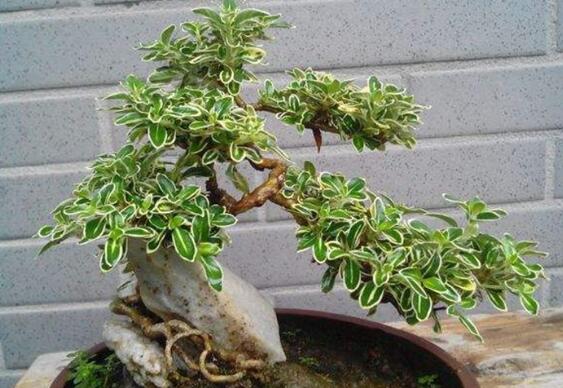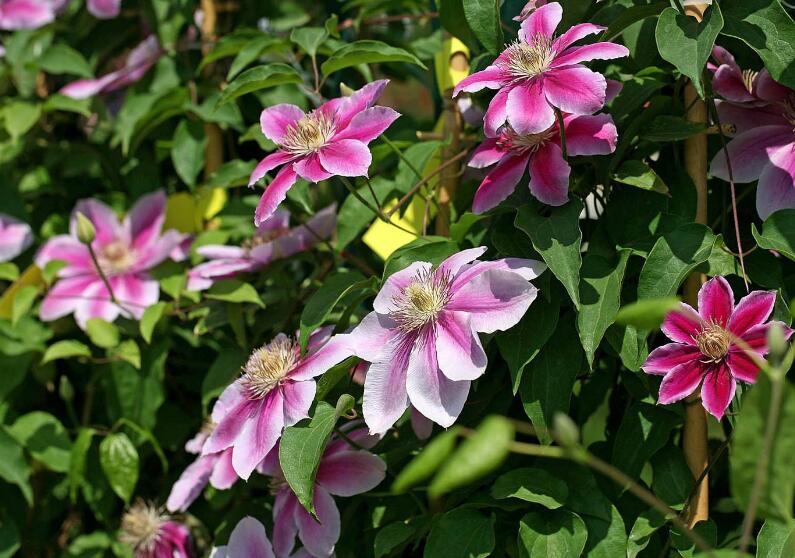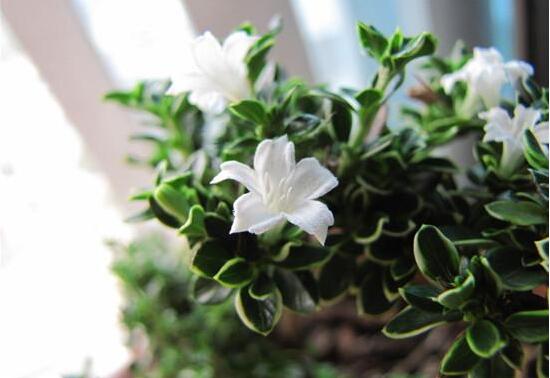June snow bonsai how to raise, June snow breeding methods and precautions / water can not be much
June snow, many flower lovers should be no stranger, it is the most popular bonsai tree, very popular at home and abroad. In life, many novices will buy June snow bonsai from the flower market, but they don't know how to keep it. In this regard, the editor carefully sorted out the breeding methods and matters needing attention of June snow, which is very comprehensive. Friends who want to raise must have a look.
How to raise snow bonsai in January and June, you can't water too much.

After buying snow bonsai in June at the flower market, we can keep it indoors or indoors. As for how to raise snow bonsai in June, in terms of light, the requirements of June snow are not high, but we must pay attention to water and fertilizer, not much, otherwise affect the growth. The details are all in the breeding methods and matters needing attention of June snow, let's move on.
Second, the culture methods and matters needing attention of June snow
1. Soil, slightly acidic
After the snow bonsai was bought back in June, there was soil inside. The soil we are talking about here is what we need when we change the basin. June snow has strong drought tolerance, so it is not strict with the soil, but if you want it to grow well, it is best to prepare slightly acidic culture soil containing humus, loose and fertile, and strong permeability.
2. Get enough light.
In the breeding method of snow in June, light is naturally indispensable, but the specific requirements depend on the situation. If you keep it outdoors, you must give enough light to the June snow; if you breed it indoors, you can put it near the window and use fluorescent lights to make up the light when the light is insufficient.
Note: once the light is insufficient, the snow in June will be very loose, and the appearance will not be so beautiful. In addition, if you breed it outdoors and want to move it indoors, you should slowly change the environment, don't get it indoors at once, and make sure that the position you put indoors can receive light.
3. Watering, rewatering when dry
How to raise snow bonsai in June, watering is very important. It is understood that June snow likes to be wet, but hates stagnant water, so we can not water too much or too often, just keep the basin soil moist, and we should see dry rewatering.
Note: when breeding outdoors, there should be no stagnant water in the basin in the rainy season to avoid rotting roots. When the summer weather is hot, in addition to watering, it is also necessary to spray water to the leaves sooner or later to cool down and increase air humidity to facilitate its growth.
4. Fertilize once a month
After watering, let's talk about fertilization. In June snow farming method, it has a demand for fertilizer, in winter, we have to reduce fertilization, from the early summer to increase the amount, fertilization once a month.
Note: when applying fertilizer, compost is moist to avoid root tip burns. Fertilization likes slightly acidic soil conditions. Stop fertilizing when June snow has lost its leaves, or if it doesn't show new growth points.
5. Temperature, 18-26 ℃
How to raise snow bonsai in June, the right temperature is very important. It is understood that June snow likes a warm, humid environment and is not resistant to cold, and the most suitable temperature is 18-26 ℃. If the room temperature is more than 15 ℃, the evergreen leaves will not fall.
Note: although June snow is adaptable, it also needs to be protected. If it is outside, it must be moved indoors when the temperature is below 7 ℃.
Matters needing attention in breeding snow in June
In the above method of breeding snow in June, several points that need to be paid attention to have been mentioned, which I believe you should remember. However, in addition to the above mentioned, there are three points that flower friends need to pay attention to, that is, pruning, turning pots and pest control. Matters needing attention in the breeding of snow in June are as follows:
1. Pruning
Snow grows fast in June, so florists need regular pruning to keep its shape. Before the leaves fall in winter every year and sprout in the spring of next year, we should trim the snow in June, cutting short long branches, overgrown branches, thinning too dense thin and weak branches, and cutting off the branches of diseases and insect pests. In the growing period, but also to pick the heart, wipe buds, remove branches, and so on, the specific operation in June snow how to trim in detail, here will not say much.
2. Turn the basin
In order to ensure that the snow in June can have sufficient nutrients, the basin needs to be turned every 1-2 years, usually in February-March in spring. Get rid of all the old soil and replace it with clean cultivated soil: loose, fertile, permeable, slightly acidic soil. When turning the basin, the roots can be trimmed properly to form suspended roots and improve the ornamental value.
3. Pest control
The diseases and insect pests of snow bonsai in June are less, but in the process of breeding, aphids, snails, root rot and other diseases will also appear, thus affecting plant growth and eventually leading to a decline in ornamental. What to do? there is a detailed introduction to the prevention and control of diseases and insect pests in the snow in June, so I won't say much here.
How to raise snow bonsai in June, a collection of breeding methods and maintenance knowledge of snow bonsai in June
Snow in June is an evergreen subtropical tree with beautiful white flowers all the year round. The trunk is coarse-textured and prickly branches grow out, forming a dome-shaped crown with the leaves. June snow bonsai how to raise, in fact, June snow farming should pay attention to a lot of things, the following article is very comprehensive about how to raise June snow bonsai and June snow bonsai breeding methods and maintenance knowledge.
The location of snow bonsai in June is exquisite.
June Snow is very concerned about its growing position, and although the tree does not like to be moved, it may be necessary to give it a happy home. When planted indoors, trees need six to eight hours of direct sunlight. It shouldn't be on the windowsill because it doesn't like temperature changes. In addition, it must be placed outside of spring or summer for a few weeks each year. This kind of tree can be planted outdoors all the year round in subtropical climates.
Problems needing attention in watering snow bonsai in June
Trees must be kept moist all the time. Maintain a regular watering schedule to dry 2/3 of the soil, and then water it thoroughly.
June snow bonsai "food feeding"
The tree is fed twice a month during the growing period. Reduce monthly feeding in autumn and winter. Don't feed the plants when the leaves fall off or the growth stops. According to the application instructions, pot fertilizer is used for feed in the form of liquid. When plants are fertilized, it is important that the soil is moist. This eliminates the risk of root burns.
June snow bonsai making video _ breeding methods and matters needing attention of June snow
June snow is also known as full star, broken leaf holly, white horse bone and so on. It belongs to a small evergreen shrub of Rubiaceae. Its height is generally 90cm, and it has a strong smell. The leaves of June snow are leathery, the petiole is very short, the flowers are solitary or many grow on the top of the branchlets or axillary, the Corolla is reddish or white, the style is more prominent, and the flowering period is usually from May to July. It has a very good ornamental value. Next, let's take a look at the bonsai making video of June snow, as well as the breeding methods and precautions of June snow.
[June snow bonsai production video]
The shape of the June snow bonsai is very elegant and beautiful, especially the edge of the leaves of the June snow in Phnom Penh is yellow, as if inlaid with a circle of gold edges, it sets off each other with the white June snowflakes in full bloom in summer. very ornamental. June snow plant is very low, and the tree shape is also very beautiful, in the hot summer will be full of white flowers, giving people a feeling as white as snow, just like its name. June snow can be bred at home as a decoration to beautify the home, bringing people a sense of beauty, and there will be a cool sense of air, just like the summer in June.
[growth habits of June snow] Hardo of June snow is a relatively small white flower with very small tree shape and loose branches and leaves. He likes to grow in lighter shady places and is afraid of the direct phenomenon of strong light. wild June snow usually grows in deep mountains and dense trees. Generally, it is divided in spring, and can be cut in the rainy season of Huangmei, and light tea can be used to call it arrogant. The temperature requirement of June snow is not particularly strict. It is generally evergreen in South China and semi-evergreen in Southwest China. Its ability to withstand drought is very strong, and the requirements for the soil are not particularly strict. If the pot is suitable for June snow in loose and fertile, permeable, rich humus-rich slightly acidic soil is more suitable, and is very conducive to the growth of June snow.
[June snow culture methods and matters needing attention] 1. Transplanting: the best time is from February to March, as well as the rainy season and the late autumn season. Transplanting pots had better choose purple sand pots and glaze pots, and the color of the choice pots should be darker, so that when the flowers open, there is a sharp contrast with the potted soil. The best requirement for basin soil is to choose sandy soil is the best, and choose loose and fertile organic soil, but also need good drainage and ventilation. Generally in humus, peat, pine needle soil, rice husk mixed with culture, but also add some base fertilizer in it, which is more conducive to the growth of plants. two。 Lighting: June snow is a kind of environment that likes to grow in a sunny, warm, moist and ventilated environment. It should be properly shaded in summer, cannot breed under strong light, and should be cultured indoors during the winter season. It also needs to maintain a certain temperature, preferably 5-12 degrees Celsius, which is ideal. 3. Watering: when raising snow in June, the basin soil should remain moist, neither too dry nor too wet, keep the right amount of water, reduce the amount of water in winter, and spray more water on the leaves in summer, usually 1-2 times. 4. Fertilization: the best time for snow in June is from April to May, usually watering phosphate fertilizer, potash fertilizer, liquid fertilizer and so on. In winter, you can fertilize again. You can irrigate thin organic fertilizer inside, but not thick fertilizer. Otherwise, it will cause damage to the plant. 5. Turn the pan: usually turn the basin every other year for June snow, which can make the soil more loose, and the plant grows faster. When turning the basin, the old soil can be removed, and the roots should be properly trimmed, which can effectively improve the ornamental value. 6. Pruning: the pruning of June snow is usually carried out in winter, pruning the long and short plants, and pruning the more dense plants, removing the more messy branches and leaves, so as to improve the ornamental value. when you encounter branches and leaves harmed by diseases and insect pests, you should prune them in time to avoid infection. To carry out de-branching, coring, sprouting and other treatments to maintain the beautiful shape of the plant. 7. Prevention of diseases and insect pests: June snow in the growth of diseases and insects is relatively few, generally aphids, you can use diluted wind oil essence spray. The disease that appears has root rot disease, can use root rot Ling or turpentine acid copper EC to add official can, generally spray once a week, continuous 3 times forehead time can be cured.
[matters needing attention for breeding snow in June] the vitality of June snow is very tenacious, but it also needs some protection. In order to avoid breeding at a low temperature below 7 degrees Celsius, you must plant indoors and maintain humidity, otherwise it will cause the plants to turn yellow, and then the leaves will fall off. Water should be properly irrigated, do not give too much or how much water, in hot or dry climate, the leaves will slowly turn yellow, thus reducing the ornamental value of June snow.
How to raise mimosa and how to raise black tulips pictures of watercress
- Prev

How to raise clematis, culture methods and precautions of clematis / pay attention to ventilation
Clematis is a kind of plant with high ornamental value, supported by the queen of rattan flowers, and it is also a kind of plant loved by many breeding enthusiasts, but there are still many aspects that need to be paid attention to if you want to raise it well. About how to raise clematis, what are the culture methods and matters needing attention of clematis?
- Next

How to water the snow in June, the method of watering the snow in June / keep the pot soil moist
June snow, also known as the sky full of stars, it not only has beautiful leaves, but also beautiful flowers and colors, white and light red are very lovable. As a highly ornamental plant, it is necessary to raise snow in June, especially in watering. We must pay attention to how to water the snow in June. The amount of water is different in different seasons.
Related
- Fuxing push coffee new agricultural production and marketing class: lack of small-scale processing plants
- Jujube rice field leisure farm deep ploughing Yilan for five years to create a space for organic food and play
- Nongyu Farm-A trial of organic papaya for brave women with advanced technology
- Four points for attention in the prevention and control of diseases and insect pests of edible fungi
- How to add nutrient solution to Edible Fungi
- Is there any good way to control edible fungus mites?
- Open Inoculation Technology of Edible Fungi
- Is there any clever way to use fertilizer for edible fungus in winter?
- What agents are used to kill the pathogens of edible fungi in the mushroom shed?
- Rapid drying of Edible Fungi

